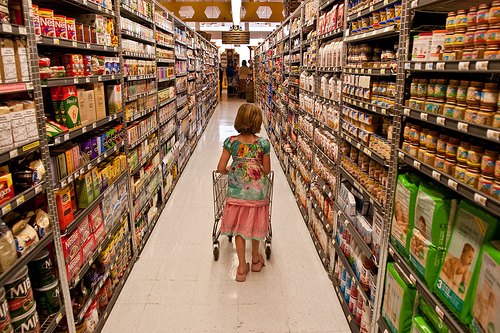Harnessing the rich detail, creativity, and individual relevance of personal narratives, Shareable.net and Latitude Research co-sponsored an innovation study to explore food information needs, information accessibility in decision-making contexts (e.g. while food shopping), and technology solutions for the future of food and offline purchasing in general.
The study (led by senior analyst Marina Miloslavsky) asked participants to tell a story about a time when they needed more information while food-shopping, and to suggest a technology solution which might have addressed their needs. The results are in!
We live in a world where we understand that any bit of information we require most likely already exists somewhere. If we have the time and energy to look, for example, we can generally discover the environmental and social impacts of our consumer choices.
But as our new study reveals, we don't always have access to that information at the times and in the places where we need it. There are instances when having more information would easily change our decisions and behaviors in ways that might help make the world a better place, say the study participants. We know the information is available through mobile and real-time technologies; it's just not available in certain everyday scenarios, like shopping in the grocery store.
If we could use new technologies to access all of the food information we desired while shopping for groceries, suggest our findings, we'd likely be healthier, happier in our environments, and more sustainable as a society.
"I'm usually not a thorough person. I'm an impulse buyer at heart. But lately I've been approaching my food shopping with the background research and patience of a 50-year old man looking for a car for his youngest daughter.
I pick up each brand and study the packaging. Where the heck is this chicken raised? I search labels, sometimes for 15 seconds until I hit on a locality. One says Pennsylvania. That's pretty close. But then I read closer and see that the distributor is located in Pennsylvania. Does that mean it's being distributed from Pennsylvania, or just that their computer systems running the complex process of shipping chicken all over the country are located in Pennsylvania? I take note of each location and then set in on my next information criteria. What are it's almost-organic or all-organic qualifications?"–Participant submission, "The Interactive Future of Food"
"The Interactive Future of Food" (Introduction for Participants) from latddotcom on Vimeo.
Current Information Demand: Background Facts + Food in Physical Space
In the context of food-shopping, more than half of participants (56 percent) expressed a primary information need relating to "background" product information, such as health, food origins, organic, farming practices, food safety, or ingredients. With new awareness of sustainability issues and the impact of our personal decision-making, it isn't surprising that we would ask for Web resources to make food origins and processes more transparent to the public.
 Participants' expressed information needs by category. In cases where participants expressed more than one type of information need, a "primary need" was coded to reflect prioritization by the participant. (n=93)
Participants' expressed information needs by category. In cases where participants expressed more than one type of information need, a "primary need" was coded to reflect prioritization by the participant. (n=93)
The second most "in-demand" category of information, 31 percent of study participants, related to navigating one's immediate physical environment–rooted in the universally relatable (and frustrating) experience of not being able to locate something you need in a store or a restaurant you'd like to eat at. When we stop to think about it, connected culture dictates that, just as we should be able to wiki clear-cut "cage-free" standards suddenly from our smartphones, shouldn't we be able to "Google Map" our way around grocery store aisles? Mobile technologies have empowered decision-making processes and blurred the line between physical and virtual information needs–by responding in real-time, anywhere we require answers.
(Of course, there are plenty of online food resources: Check out Sourcemap, a tool for researching and optimizing the supply chains behind everyday products, and LocalHarvest and SharedHarvest to find sustainably grown food in your area.)
Information Scarcity: Credibility and Context
As it happens, people often aren't getting the answers they need. Among the participants who didn't have their information needs resolved at all, a majority (59 percent) ultimately made purchases regardless–and one in five people explicitly mentioned that this was a recurring experience. In addition to an accessibility issue (simply getting the information we need where we are, when we need it–we'll explore the technology solutions that participants generated in our next post), one possibility is that people simply don't know where to locate trustworthy information.
"What is a transfat? Why don't I want it in my crackers? How do I recognize products that are bad for me? Most people want to eat healthily, they just don't necessarily know how, and supermarkets don't actively help." –Participant submission, "The Interactive Future of Food"
For example, only 14 percent of participants said they would have liked to receive background product information from the product's supplier; conversely, 51 percent said they'd like to hear this type of information from stores (response options were not mutually exclusive)–indicating a possible opportunity for stores to alleviate information-frustration by building out user tools and extending this root sense of trust.
After all, purchasers are increasingly information-autonomous, and "Web 2.0" philosophy rewards businesses which facilitate information transparency and accessibility. The integration of social information streams presents another avenue for connecting individuals to trusted information, as today's benchmark for unbiased information–especially consumer-related information–becomes the consensus of the social aggregate.
Why Isn't There an App for That?
What's clear is that no matter what type of information people required in trying to make informed purchases, the solution was often perceived to be a mobile one. In fact, three in 10 participants (six times the number of people who actually used smartphones while shopping!) suggested mobile solutions to their own information dilemmas.
It didn't matter whether I wanted to know if the store's tomatoes were locally grown, if I wanted a price comparison with other stores in a five-mile radius, if I wanted credible standards for "organic," or if I just needed to track down this store's tabouli: mobile was just as likely to be perceived as the answer to one information need as another–and by people who aren't currently smartphone users in this context. Mobile has become an integrated solution for informed, real-time decision-making–an expected offering–rather than simply a platform for accessing superfluous, "nice-to-know" information.
Next: An in-depth look at the common solution attributes that participants generated in solving their varied information challenges. For a more detailed overview of the study, see this PDF.
Latitude recently donated $500 to The Hunger Project, a global non-profit committed to the sustainable end of world hunger, on behalf of the individuals who contributed their time and thoughtful narratives to "The Interactive Future of Food."









